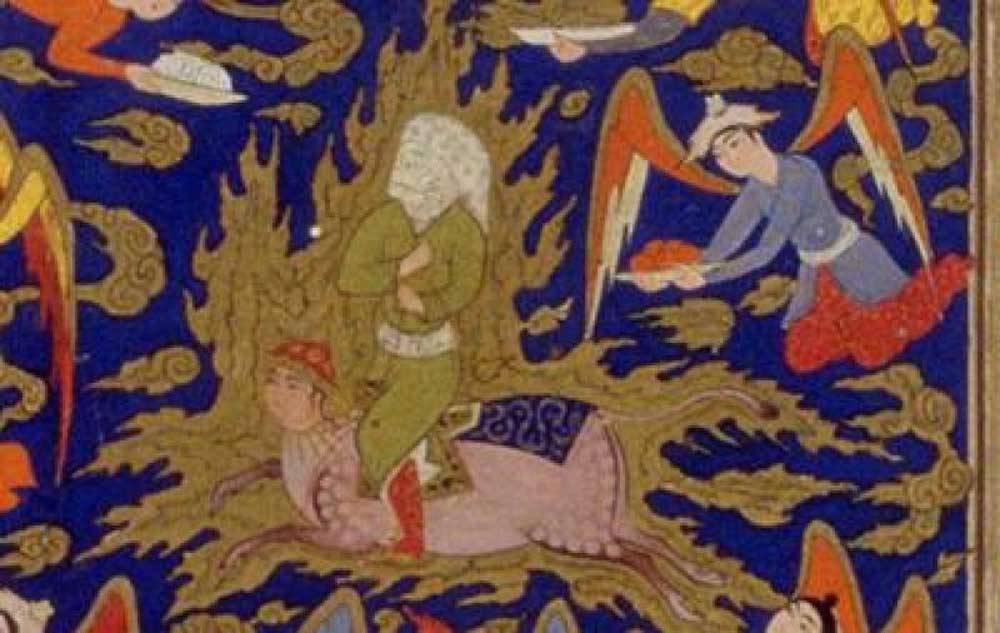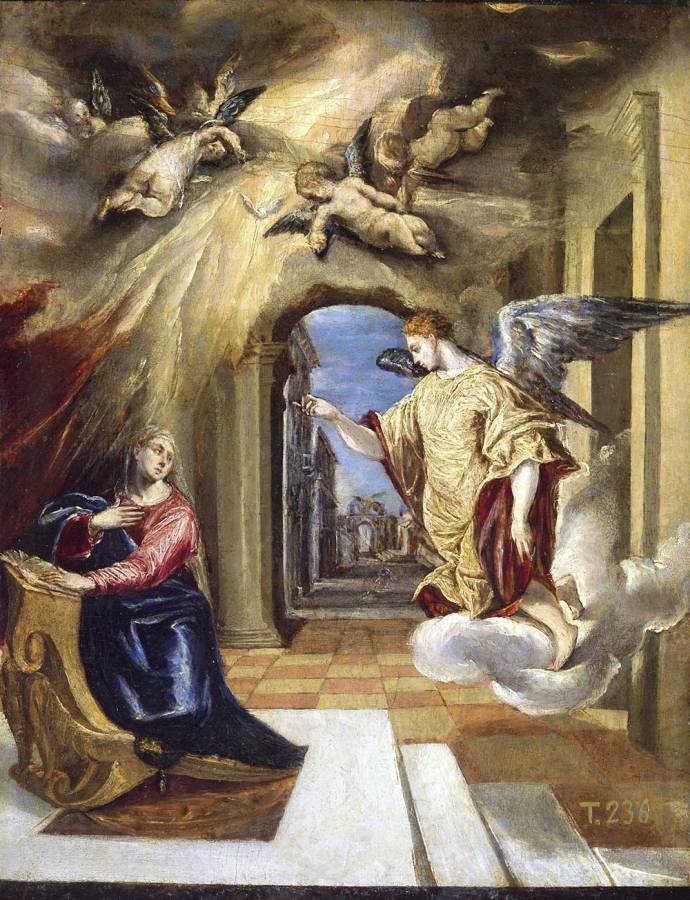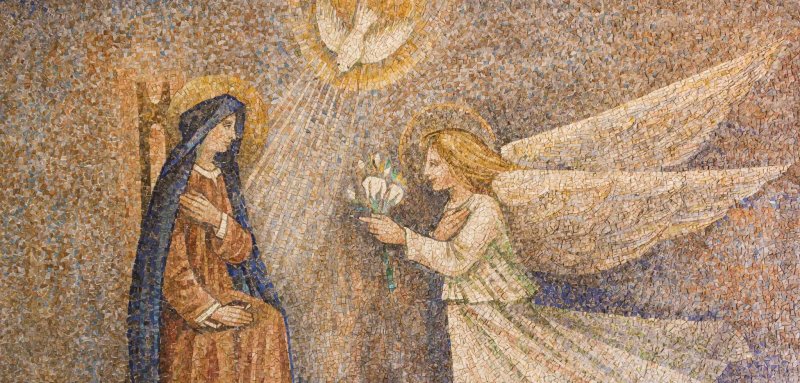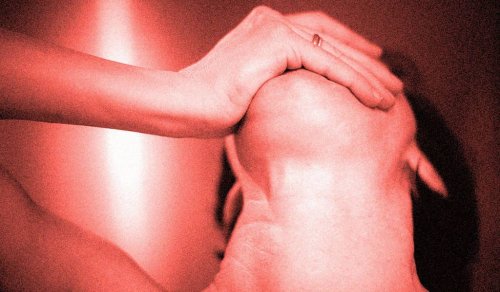The carrier of Islam’s first revelations, and the messenger through whom divine orders were conveyed from the skies to the Prophet Muhammad in Mecca and Medina: the archangel Gabriel occupies an eminent place in the hearts of Muslims, and is considered the greatest angel within the Islamic tradition. It is at his hands that the first message of Islam was revealed to Muhammad in the Cave of Hira outside of Mecca, and it is at his hands that it ended; that is, when the angel of death requested his permission to enter during the final moments of the Prophet’s life.
The role played by Gabriel in the life of the Prophet occupies a wide berth within historical narratives – not solely from the religious angle, but extending to a host of personal issues. When the Prophet fell ill, we are informed that Gabriel descended from the skies to watch over him; and when the Prophet sought to marry a virgin, it was Gabriel that advised him to choose Aisha – one of the Prophet’s most famous and beloved wives, and daughter of his companion Abu Bakr al-Sadiq.
When the Prophet decided to divorce his wife Hafsa, he was told by Gabriel to reverse his decision, as she “kept her fast” and stayed awake in prayer during the latter parts of the night. And when Iblis (Satan) took the Prophet by surprise at the Battle of Badr (when he emerged to support the polytheists/pagans), Gabriel immediately appeared to reinforce the rank of the believers.

Indeed, the examples are countless: when a sorcerer cast a spell on the Prophet which caused him to fall ill, Gabriel guided the Prophet to his place so that he could help him recover while passing the time with mirth. These are only some of the stories which reveal how the relationship between the Prophet and his angelic “friend” evolved.
However, Gabriel’s heroisms weren’t only confined to the Prophet or just to the championing of the message of Islam, but branched out to encompass so many others.
Gabriel’s heroisms weren’t only confined to the Prophet or just to the championing of the message of Islam, but branched out to encompass so many others.
A sixteenth-century Persian manuscript shows the ascendance of the Prophet Muhammad (with his face concealed, as mainstream Islamic tradition forbids visual portrayals of the Prophet) while riding the Buraq (a horse-like steed) during the trip of the Isra and Mi’raj (the ‘night journey’ in which according to Islamic belief, the Prophet travelled to the Al-Aqsa Mosque in Jerusalem in a single night, before ascending from there to heaven) – with the angel Gabriel appearing on his right side. Gabriel accompanied the Prophet in his trip from Mecca to Jerusalem. The manuscript appears in faded watercolour, whilst gold was also used in its painting. The manuscript is present today in the Fine Arts Museums of San Francisco.
Islam’s history books have dedicated considerable space to Gabriel’s role in championing the calls of God’s messengers, from Adam to Jesus. These attempts were discussed very early on in Islamic history – indeed, going as far back as the moment of the Prophet’s revelation itself.
In his celebrated works “The Beginning and The End”, medieval Qur’anic scholar and historian Ibn Kathir recounts that when the Prophet told his first wife, Khadija, that Gabriel appeared to him with the revelation (Wahy) in the Cave of Hira, she sought the observations of two individuals. The first, a pious slave belonging to Utba bin Rabi’ah named Ghadas, informed her that what had manifested to her husband “was with Moses when God drowned Pharoah and his people, and was with him when he talked to God on the Tur [Mount Sinai], and he was a companion of Īsā ibn Maryam [Jesus] that God aided him with.”
Khadijah then sought Waraka ibn Nawfal, her cousin, who described Gabriel as the “companion of the prophets” before adding: “For if Gabriel’s feet settled on the floor of the earth [then] he has descended on the best of the people of the earth, and he did not descend except on a prophet.”
The care shown in securing and presenting these moments appears to be an attempt to form a correlative relationship between two parties on whom the religion was built; for every time we bestowed praise upon one, the other shone in turn. This was so in order to confer a further honouring onto the Prophet for the writings that would follow his message – as well as bequeathing him greater credibility in his public call to the faith when he decided to declare his mission in the open. Thus, if Gabriel – the champion of the messengers and the possessor of the keys to divine speech – decided to appear to Muhammad in the cave, then it must be that he is the “best of the people of the earth” as Waraka described him: a prophet believed and entrusted by the upper echelons, arriving with a momentous message that must be followed.
Indeed, whenever we scrutinise more the relationship between the Prophet Muhammad and the Archangel Gabriel, we find that their relationship within Islam was vested with greater majesty than in prior faiths. The purpose appears to go beyond proselytizing to the followers of other religions, but to establish Islam as a faith that is a step ahead of other religions, as per the Qur’anic decree: “Truly, the religion with Allah [God] is Islam.” (3:19)
Building the Kaaba with Adam
Following the harsh shock of his expulsion from paradise and his descent to earth, God’s first creation was overcome with depression and surrounded by adversity. In his book “The History of Damascus”, the 11th century scholar Ibn `Asakir relates that Gabriel appeared to Adam whilst he was “crying with his head in his hands.” Once Adam saw the angel, he started to complain to him about his fall from grace and decline in fortune: “from the kingdom of heaven to the baseness [degradation or helplessness] of the world.”
Gabriel returned to God and relayed what his first human creation had said. God would order Gabriel to deliver the following glad tidings to Adam: “O Adam, my mercy has preceded my anger, I have heard your voice and invocation [plea] and am merciful on you and have carried [lifted] you from your stumble.” This event has been cited to identify the essence of the “words” mentioned in the Qur’anic verse: “Then Adam received from his Lord [some] words, and He accepted his repentance.” (2:37).
Meanwhile, in his book “The Definitive Word in the Biography of the Master of the Messengers”, Muhammad Tayyib al-Najjar outlines multiple possible candidates for the first builders of the Kaaba in the holy city of Mecca. Amongst these is that Adam was the first to build the Kaaba, with the help of Gabriel.
Here, Najjar accordingly cites a narration (Hadith) attributed to the Prophet Muhammad in which God sends Gabriel to Adam and Eve and orders them to build a ‘house’ – whose boundaries God himself has marked. They obeyed the command (making “Adam dig and Eve move the dust”) and when they finished were ordered by God to circle the Kaaba to perform Tawaf, or circumambulation (an Islamic ritual in which Muslims circle the Kaaba, notably as part of pilgrimage).
The medieval Egyptian historian Al-Nuwayri (in “The Ultimate Ambition in the Arts of Erudition”) also details another occasion bringing Adam and Gabriel together with the Kaaba. He narrates that Gabriel descended to Adam and dressed him in a white garment performing the Tawaf with him, and teaching him the rites of the pilgrimage.
Indeed, the very first time that the father of humanity wore clothes, farmed and ate bread were all through the revelations of the greatest of the angels, Gabriel. Ibn al-Jawzi mentions in his “Well-Ordered History of Kings and Nations” that Gabriel came to Adam and ordered him to shear a sheep; when he did so, Eve knitted two robes for her and her husband. Al-Tabari too notes in his celebrated “History of the Prophets and Kings”, that when Adam got hungry, he invoked God for food; Gabriel was sent bringing him seven grains of wheat, which he then taught him how to grow, harvest, collect and grind, before finally putting it on a fire, thus becoming “the first to bake.”
Finally, when Adam died it was Gabriel who led the prayer over his soul, as Al-Suyuti details in his “Arrangement of the Tradition about Angels”.
Building the Ark with Noah
As with the Prophet Muhammad, Al-Nuwayri relates that Noah was also first foretold of the glad tidings of his prophethood by Gabriel. Gabriel would subsequently encourage Noah to publicly announce his prophethood for the first time at one of his people’s pagan celebrations – an official holiday held in honour of their idols. Noah accepted, courageously seizing the opportunity of their assembly to call them to worship God.
According to Al-Shinqiti (in “The Wholesome Waters of the Councils of Exegesis”), when Noah would later build his ark – in accordance with God’s order to “Build an ark with Our eyes and by Our revelation [inspiration]…” (Qur’an, 11:37) – Gabriel would emerge as the first teacher in the construction of this historic vessel, and Noah his first student.
This is endorsed by Murtada al-Zabidi in his tome, “Bride’s Crown” (Tāj al-ʿArūs), where he cites the Prophet Muhammad’s hadith declaring: “The chief of building on Noah’s ship was Gabriel.” Jewish popular tradition accords Gabriel a larger role in the building process: attributing the powerful voice which ordered Noah to assemble the animals on the ark before the great flood to the angel himself.
Extracting Hajar’s Zamzam
Renowned Persian scholar Al-Tabari relates that when the prophet Abraham’s tribe assembled to kill him and bring his message to an end – tying him in preparation to throw him into a fire – Gabriel arrived and asked him: “O Abraham, do you have need of something?” However, even in the midst of such adversity the father of the prophets refused; for he did not want his heart to need anyone other than God. Thus, he answered: “As to [from] you, then no.” The story was mentioned in a similar form in the Talmud – which anointed Gabriel as “king of fire” for his role in saving Abraham.
In his Tafsir al-Jalalayn (Commentary on the Qur’an), Al-Suyuti expounds on the verse: “And inform them about the guests of Abraham” (15:51) – explaining that the “guests” here refer to twelve angels including Gabriel, who had come to bring Abraham the promise of a coming child and the destruction of the people of Lot.
Onto the story of the lady Hajar, in a narration of the prophet Muhammad (relayed by Abul Hasan Al-Daraqutni in his Hadith collection) the Prophet described the water of Zamzam (which Muslims believe to be miraculous by virtue of the story of Abraham’s wife Hajar, and is drawn out of a well near Mecca) as “Abraham’s indentation [literally ‘defeat(ing)’, meaning Gabriel’s breaking of the ground’s surface], and Ashmael’s water [drink].” This was the same meaning referred to in another narration (relayed by Ibn Hibban in his Sahih – or authentic Hadith collection), where the Prophet said that Gabriel “made Zamzam run [despite] its obstacle”, causing the water to burst forth.
Abraham’s wife Hajar (trapped in the middle of the desert with her baby Ishmael, and without her husband) subsequently rushed to scoop as much water as she could in her hands, lest it disappear. The fear would prove unfounded however (the Zamzam well still produces water today), prompting the Prophet to remark: “God have mercy on Hajar, if she had left it would have never stopped [literally, a ‘sustaining fountain’].
Hajar’s story has a distinctly similar parallel to the 18th Chapter of the Old Testament – where the Israelites and Moses are lost in the wilderness – with the exception of some minor details.
Gabriel would also show Abraham the location of the original foundations of the Kaaba (as Al-Fakihi relates in his book, “The news of Mecca”), which Abraham subsequently rebuilt once again. To this, Shuaib Al Arna’ut adds in his 45-volume work on Musnad Ahmad (i.e. the collection of hadith compiled by Ahmad ibn Hanbal, founder of the Hanbali school of jurisprudence) that it would be Gabriel who would teach Abraham the rites of pilgrimage: taking him to the largest Jamrah (one of three pillars representing the devil, which following the example of Abraham, is stoned by worshippers during the annual major pilgrimage of Hajj) and onto Mina (an area near the stoning site, and which became a compulsory pilgrimage stop), before finally reaching a mountain.
On it, he asked Abraham: “Do you know?” to which Abraham replied “Yes.” The mountain would come to be known as Arafa – literally “He knows” – derived from the question (Hal Araft?) put to him by Gabriel. Its visitation forms the last stage of the Muslim Hajj (major pilgrimage).
Finally, in his book “Awaking the residing resolve towards the most honourable of places” (Muthir al-‘Azm al-Sakin ila Ashraf al-Amakin), Ibn al-Jawzi speaks of the terrible test that encountered Abraham after he saw a vision where he slaughtered his son (Ishmael). Abraham told his son of his vision, to which Ishmael replied “O father, do what you are commanded; you will find me God willing among the patient” (Qur’an 37:102).
When the arduous moment arrived, Abraham wept and wailed; however, as he put the knife on his son’s throat it was overturned. Abraham then suddenly heard his name being called: “O Abraham, you have believed the vision… this is the sacrifice of your son.” He looked around him to find the angel Gabriel by his side along with a black-headed ram to slaughter instead. To this day, Muslims annually commemorate the event by slaughtering a ram during the Eid al-Adha – or the “Celebration of sacrifice”, the longest of the two Muslim Eids.
Preventing the repentance of the Pharaoh of Moses
The Talmud narrates that when the maids of the daughter of Egypt’s Pharoah tried to discourage her from saving Moses after his mother threw him in the river, they were counteracted by Gabriel. Gabriel additionally taught the adult Moses how to make the Menorah – a symbol of the Jewish religion.
Meanwhile, it is narrated (in Tirmidhi’s collection of Hadith) that the Prophet Muhammad said that Gabriel, when Pharoah was drowning, in order to prevent him from declaring his repentance before his death, “thrust mud from the sea into his mouth, lest [God's] mercy embrace him.”
Furthermore, an article by the Comprehensive Islamic Encyclopaedia notes that Gabriel came to the aid of Moses against Egypt’s sorcerers. Moreover, during the Israelites’ escape from Egypt he appeared on a “white mare” to urge the Egyptians to plunge into the parted sea – only for the waves to fold on top of them as they perished behind Moses and his people, thus saving them from their avarice.
Here is your son, O Jacob
After the prophet Jacob lost his two sons Joseph and Benjamin, his grief arched his back and his eyes were blinded by the weight of tears they had shed. Al-Suyuti relates in his “Comprehensive compilation” of Hadith, that Gabriel arrived once again as a harbinger of good news, bringing a divine message to Jacob which read: “Bode well [of a good omen], and let your heart rejoice”. Indeed, according to the Talmud Gabriel took it upon himself to teach Joseph the seventy languages then-spoken in the world.
Meanwhile, in his Tafsir (exegesis or interpretation) of the Qur’an, Muhammad Al-Amin Al-Hirari expounds on Jacob’s day of “glad tidings and heart’s joy.” This takes place with Jacob taking his entire kin to Egypt, after being invited there by his Joseph. When he arrives, Jacob asks Gabriel “Which of them is my boy Joseph?” Gabriel replied: “It is him with a shadow above his head.” Jacob proceeded to his son, and they “hugged and cried with joy; the knights surged amongst each other, and the horses neighed and the angels praised [God], and the drums were beaten and the horns [blown], and it was as if it was the day of resurrection.”
Relaying the account of Anas ibn Malik, Abu Talib al-Makki – in “The Guidance until Reaching the End” (Al-Hidaya Ila Buhigh Al-Nihaya) narrates that after Joseph returned to his son Jacob and his whole family was reunified, Joseph’s brothers asked their father to lead them in prayer and to ask God to forgive them. This forgiveness would only arrive after twenty years, when Gabriel descended to Jacob and said: “God sent me to you and I bode well for you: that he has answered your prayer regarding your sons, and he has forgiven what they made [did].”
The bearer of the holy breath
In one of his lecture series, Sheikh Muhammad Salih al-Munajjid illustrates in detail the process by which Gabriel appeared to the virgin lady Mary. Heralding the good omen of bringing a “Word” from God, Gabriel – the vehicle of the Divine Spirit – breathed into Mary from God’s Spirit (Al-Munajjid specifically interprets the process as breathing into the “neck opening of her garment”). The angel’s breath entered her womb, impregnating Mary by God’s will.

Meanwhile, when interpreting the Qur’anic verse “Then (a voice) called her [Mary] from below her…” (19:24), Al-Baghawi relays Ibn Abbas’s explanation that the “caller” here was Gabriel. Gabriel proceeds to tell Mary not to fear or grieve – for God had created a “stream” for her. Ibn Abbas elucidates that the “stream” burst forth after Gabriel hit the ground with his foot – poignantly resembling the experience Hajar and Ishamel encountered after the same foot burst the well of Zamzam open in an arid valley. In other words, Gabriel thus saved the lives of two prophets while they were still in the cradle.
One day many years later, and after finishing his prayers as a grown man and messenger of God in Jerusalem, Ibn Kathir relates (in his “From the Beginning to the End”) that Jesus was intercepted on his departure from prayers by Iblis (the devil). Iblis attempted to tempt Jesus into disobedience, repeating the statement “It is not fit for you to be a slave [i.e. to God].” Jesus thus asked God for assistance, and his Lord answered his prayers, sending him the angels Gabriel and Michael. Gabriel struck Iblis with his wing, and he was thrown into the bottom of the valley.
According to Ibn Abbas’s narration, Gabriel continued to play a crucial protective role until Christ’s last moments on earth. Thus, when the king of the Israelites decided to kill him, he was ordered by the Holy Spirit (i.e. Gabriel) to seek protection inside a house; from which Gabriel raised him to the skies and saved God’s prophet from death.
Raseef22 is a not for profit entity. Our focus is on quality journalism. Every contribution to the NasRaseef membership goes directly towards journalism production. We stand independent, not accepting corporate sponsorships, sponsored content or political funding.
Support our mission to keep Raseef22 available to all readers by clicking here!
Interested in writing with us? Check our pitch process here!





